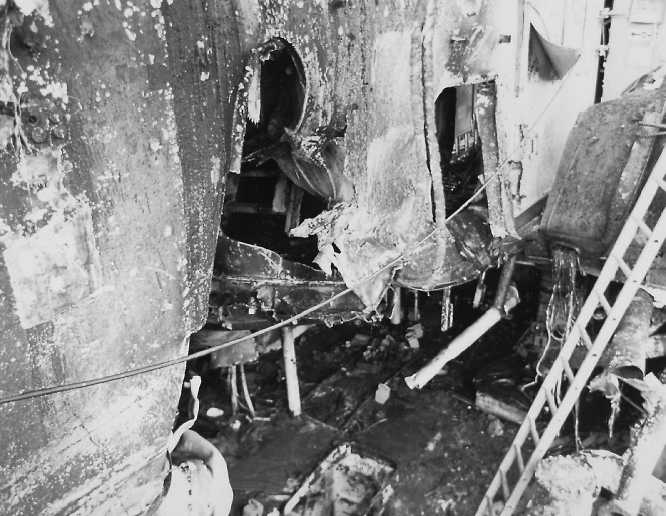| |
134.2
Figure 2-17.-Damage to the USS Stark.
Enjoying a break from tanker escort duty, the
Roberts was headed to the southern part of the
Persian Gulf for a scheduled replenishment. At
1639 Boatswain’s Mate Seaman Bobby F. Gibson,
standing the bow watch, saw what he thought
were three dolphins off the starboard bow.
Dolphins had been spotted earlier in the day and
were commonplace in the gulf. Only this time the
“dolphins” weren’t going back under water. He
grabbed his binoculars, spotted the spikes on the
floating objects, and immediately notified the
bridge. The officer of the deck (OOD), Lt. Robert
L. Firehammer, Jr., then called the commanding
officer (CO), Commander Paul X. Rinn, who was
on the bridge in a matter of seconds. Rinn ordered
the ship to “all stop.”
Normally, mines found in the gulf were old and
encrusted with sea growth. Looking through the
“big eyes,” a powerful set of binoculars,
Quartermaster Second Class (Enlisted Surface
Warfare Specialist [SW]) Dan J. Nicholson’s heart
sank at his first glimpse of the floating objects.
They were shiny and the sun glared off them.
QM2 Nicholson thought, Whoa, this is real—big
time! Over the ship’s general announcing circuit,
the 1MC, the captain told his crew their ship had
entered a minefield. He called all hands to general
quarters (GQ) and told them to check that con-
dition Zebra was set throughout the ship. Within 3
minutes the GQ stations were manned and Zebra
was set.
Back on the fantail, the chocks and chains were
removed from the ship’s helicopter. Boat-swain’s
Mate Second Class Kim T. Sandle prepared to
launch the helo to drop floats, flares, and smoke
near the spotted mines.
Rinn went to the starboard bridge wing,
looking back at the ship’s wake. He knew if
he kept the ship in the wake, it would be
safe. He ordered the lowering of the
auxiliary propulsion units (APUs), built in
the forward part of the ship to maneuver
in tight quarters at low speed. Rinn then
2-25
|

